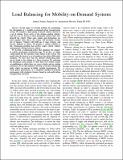Load Balancing for Mobility-on-Demand Systems
Author(s)
Durrant-Whyte, H.; Roy, Nicholas; Abbeel, P.
DownloadFrazzoli_Load balancing.pdf (541.0Kb)
OPEN_ACCESS_POLICY
Open Access Policy
Creative Commons Attribution-Noncommercial-Share Alike
Terms of use
Metadata
Show full item recordAbstract
In this paper we develop methods for maximizing the throughput of a mobility-on-demand urban transportation system. We consider a finite group of shared vehicles, located at a set of stations. Users arrive at the stations, pick-up vehicles, and drive (or are driven) to their destination station where they drop-off the vehicle. When some origins and destinations are more popular than others, the system will inevitably become out of balance: Vehicles will build up at some stations, and become depleted at others. We propose a robotic solution to this rebalancing problem that involves empty robotic vehicles autonomously driving between stations. We develop a rebalancing policy that minimizes the number of vehicles performing rebalancing trips. To do this, we utilize a fluid model for the customers and vehicles in the system. The model takes the form of a set of nonlinear time-delay differential equations. We then show that the optimal rebalancing policy can be found as the solution to a linear program. By analyzing the dynamical system model, we show that every station reaches an equilibrium in which there are excess vehicles and no waiting customers.We use this solution to develop a real-time rebalancing policy which can operate in highly variable environments. We verify policy performance in a simulated mobility-on-demand environment with stochastic features found in real-world urban transportation networks.
Date issued
2012Department
Massachusetts Institute of Technology. Department of Aeronautics and AstronauticsJournal
Robotics: Science and Systems VII
Publisher
MIT Press
Citation
Durrant-Whyte, H., N. Roy, and P. Abbeel. "Load Balancing for Mobility-on-Demand Systems ." In Robotics: Science and Systems VII , Cambridge, MA: MIT Press, 2012. pp. 249 - 256.
Version: Author's final manuscript
Other identifiers
Paper-ID #184
ISBN
9780262305969